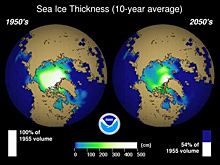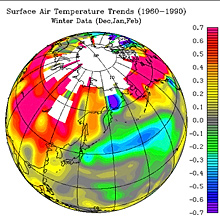The First Climate Model
- Ocean & Atmosphere Interactions
- Testing the Notion of Global Warming
- The First Climate Model
- Modern Model Descendants
A Model Based on Ocean and Atmosphere Interactions

Climate models are systems of differential equations based on the basic laws of physics, fluid motion, and chemistry. To “run” a model, scientists divide the planet into a 3-dimensional grid, apply the basic equations, and evaluate the results. Atmospheric models calculate winds, heat transfer, radiation, relative humidity, and surface hydrology within each grid and evaluate interactions with neighboring points. Click image for larger view.
In the late 1960s, NOAA’s Geophysical Fluid Dynamics Laboratory in Princeton, New Jersey, developed the first-of-its-kind general circulation climate model that combined both oceanic and atmospheric processes. Scientists were now able to understand how the ocean and atmosphere interacted with each other to influence climate. The model also predicted how changes in the natural factors that control climate such as ocean and atmospheric currents and temperature could lead to climate change. The model still stands today as a breakthrough of enormous importance for climate science and weather forecasting. Earlier knowledge of the oceanic and atmospheric circulation, and their interactions, was based purely on theory and observation.
Climate models are computer-based simulations that use mathematical formulas to re-create the chemical and physical processes that drive Earth’s climate. This pioneering model included all the basic components of climatic factors (atmosphere, ocean, land, and sea ice), but covered only one-sixth of the earth’s surface, from the North Pole to the equator and 120 degrees of longitude east to west.
Testing the Notion of Global Warming

Climate models are the primary means to estimate the effects of increasing greenhouse gases on future global climate. Here a model projects a substantial decrease in the 10-year average of Arctic sea ice thickness (in centimeters) during the decade starting in 2050 compared to a century earlier. Click image for larger view.
Two scientists from the Geophysical Fluid Dynamics Laboratory, Drs. Syukuro Manabe and Kirk Bryan, published the model results in 1969. By the 1970s, general circulation models emerged as a central tool in climate research. Dr. Manabe and Mr. Dick Wetherald later used this original model to simulate the first three-dimensional experiment to test the notion of global warming. Their groundbreaking results were published in 1975.
The Vision and Hardware Behind the First Climate Model

To accommodate growth in the size of model outputs, NOAA has invested in a computing infrastructure that can hold 2,000 terabytes (or two million gigabytes) of data. With this capacity, scientists now have the ability to store global climate data on a weekly or even daily basis to investigate climate change. Click image for larger view.
The development of this first climate model was based on Geophysical Fluid Dynamics Laboratory founder Joseph Smagorinsky’s belief that only a completely new approach to scientific endeavor that departed from the independent, individual mode of inquiry would produce answers to extremely complex problems. He realized that it would take large-scale numerical modeling, with teams of scientists using commonly shared high-speed computers for experiments, to achieve such an important breakthrough.
The computer used to develop and run the first model was a Univac 1108 with half a megabyte of memory—not enough to store a song or a high-resolution picture today. Most watches, cell phones, MP3 players, and other electronic gadgets now have computer chips that process faster than the Univac 1108. It took 20 minutes to run one model-day for just the atmosphere. The modern supercomputer at NOAA's Geophysical Fluid Dynamics Laboratory (GFDL) currently provides more than 100,000 times the computing power of that early computer.
The journal Nature, volume 440, 2006, in a paper titled “Milestones in Scientific Computing,” cited GFDL’s original climate model among other breakthroughs, which have had a profound effect on our lives. Others cited were the first CT scanner, the first hand-held scientific calculator, and the Internet.Modern Model Descendants

Computer models have long predicted that the climate change will affect Arctic and subarctic regions earlier and more dramatically than other parts of the world. Recent studies show marked increases in temperature and many other climate variables across much of the far north. Observed trends in surface air temperature from 1960-1990 (shown above in degrees centigrade) demonstrate "polar amplification,” with largest temperature increases (shown in red and magenta) occurring near the North Pole. Click image for larger view.
Thirty-seven years (2006) and tens of models later, GFDL recently developed the next generation in modeling infrastructure–the Flexible Modeling System, which provides a common platform for diverse research activities, from weather to seasonal prediction to anthropogenic (man-made) climate change. With this new system, GFDL scientists developed, and now are using, two world-class climate models that have significantly enhanced capabilities relative to the world’s first revolutionary climate model that GFDL scientists ran over three decades ago.
Recently, GFDL scientists have used a “descendant” from the very first climate model to examine possible climate changes over the next several centuries that may be induced by increasing atmospheric levels of carbon dioxide. Earlier studies had focused on shorter time horizons. In model results, carbon dioxide quadruples over a period of 140 years, then no longer increases. This perturbation is enough to cause the ocean's global thermohaline circulation to almost disappear in the model. This circulation is important because the ocean is responsible for a large portion of the heat transport from the tropics to higher latitudes in the present climate.
In addition, according to model results, sea level continues rising steadily for centuries after the carbon dioxide increase halts. From this perspective, the model, using the best available data and understanding of how climatic factors interact, predicts that a steadily warming planet will be with us for generations to come. The first climate model continues to exert its far-reaching influence through its improved and refined model descendants that scientists apply to help understand and predict the most challenging climate issue of our time.










